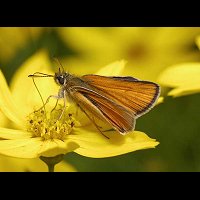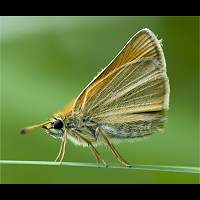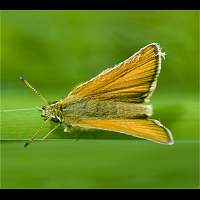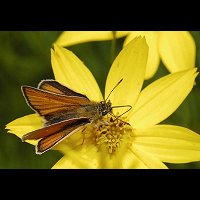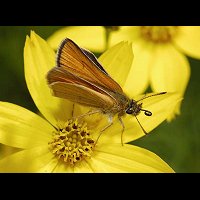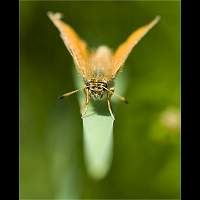Essex Skipper Thymelicus lineola
The Essex Skipper is one of the smallest reddish skippers. It is extremely similar to the Small Skipper, but it is smaller. The two species can be told apart by looking at the ends of the antennae. And I mean the tips of the antennae, not the part just in front of that. In the Small Skipper the tips are yellowish and in the Essex Skipper the tips are black. Males can be told apart by looking at the scent lines on the wings. The Essex Skipper has one rather thin line, running parallel to the veins. The Small Skipper has an additional thick line, usually bent, running across the wing. Other similar species, such as the Large Skipper are not only larger, they also have light patches in the wings, lacking in the Essex Skipper and the Small Skipper. The Essex Skipper will reach a wingspan of some 22 to 26mm only.
The eggs are round, white and are deposited one by one during the period the animal is on the wing. The embryo soon changes into a caterpillar, but it stays inside the egg. It is not before April of the next year the caterpillar gets out of its egg and starts feeding. Once it does, it develops rapidly indeed: the first adult Essex Skippers may appear by the middle of June. The larva is green, with a dark green dorsal line. On the sides two lightgreen or whitish lines. It is similar to many other caterpillars, but the markings on the head usually give it away. The head is green. On top are three brown bands and the area between these bands is white. The caterpillars live on and in many species of grass. They are extremely fond of Timothy Grass. They may reach a length of some 24 mm.
Like other skippers, the Essex Skipper loves to fly. But it does fly clumsely like a butterfly and not like some owlets moths to which it bears a great resemblance. It may be found on a large range of flowers and doesn't seem to be very particular in that respect. It is on the wing from the middle of June to the middle of August. It was taken to the USA accidentally in 1910 and soon became a wide spread pest in grasslands in the North Eastern part of the USA and the eastern part of Canada. In these parts Timothy Grass is grown for hay. Sometimes the Essex Skipper makes up for 80% of all butterflies present! Actually the animal is present in most parts of Europe, except for Sardinia and the northern parts of Britain and Scandinavia, all over moderate Asia and Japan. In Britain found especially in England and Southern Wales, but it is rapidly expanding its territory and probably is overlooked many times because it is so similar to the Small Skipper.
In the USA this species is better known as the European Skipper.
The Essex Skipper is one of the smallest reddish skippers. It is extremely similar to the Small Skipper, but it is smaller. The two species can be told apart by looking at the ends of the antennae. And I mean the tips of the antennae, not the part just in front of that. In the Small Skipper the tips are yellowish and in the Essex Skipper the tips are black. Males can be told apart by looking at the scent lines on the wings. The Essex Skipper has one rather thin line, running parallel to the veins. The Small Skipper has an additional thick line, usually bent, running across the wing. Other similar species, such as the Large Skipper are not only larger, they also have light patches in the wings, lacking in the Essex Skipper and the Small Skipper. The Essex Skipper will reach a wingspan of some 22 to 26mm only.
The eggs are round, white and are deposited one by one during the period the animal is on the wing. The embryo soon changes into a caterpillar, but it stays inside the egg. It is not before April of the next year the caterpillar gets out of its egg and starts feeding. Once it does, it develops rapidly indeed: the first adult Essex Skippers may appear by the middle of June. The larva is green, with a dark green dorsal line. On the sides two lightgreen or whitish lines. It is similar to many other caterpillars, but the markings on the head usually give it away. The head is green. On top are three brown bands and the area between these bands is white. The caterpillars live on and in many species of grass. They are extremely fond of Timothy Grass. They may reach a length of some 24 mm.
Like other skippers, the Essex Skipper loves to fly. But it does fly clumsely like a butterfly and not like some owlets moths to which it bears a great resemblance. It may be found on a large range of flowers and doesn't seem to be very particular in that respect. It is on the wing from the middle of June to the middle of August. It was taken to the USA accidentally in 1910 and soon became a wide spread pest in grasslands in the North Eastern part of the USA and the eastern part of Canada. In these parts Timothy Grass is grown for hay. Sometimes the Essex Skipper makes up for 80% of all butterflies present! Actually the animal is present in most parts of Europe, except for Sardinia and the northern parts of Britain and Scandinavia, all over moderate Asia and Japan. In Britain found especially in England and Southern Wales, but it is rapidly expanding its territory and probably is overlooked many times because it is so similar to the Small Skipper.
In the USA this species is better known as the European Skipper.

